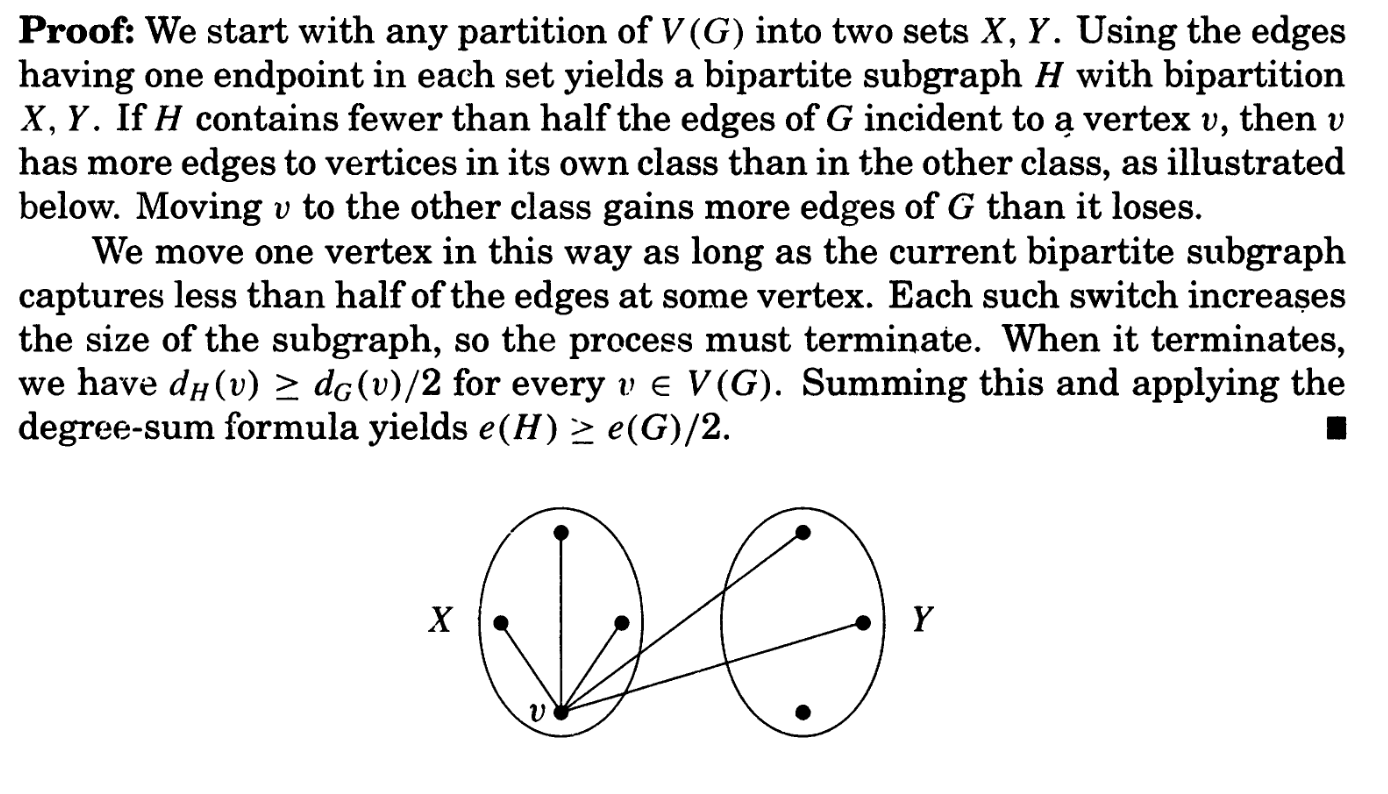Probabilistic methods in DM: Example 1
Theorem 1(Claim).
Every graph can be converted to a bipartite graph by deleting edges. Moreover, every graph with edges has a bipartite graph with at least edges (so one has to remove at most edges to make the graph bipartite.)
Probabilistic Proof
The lemma is equivalent to showing “every graph vertex set can be partitioned into two parts such that there are at least edges between the two parts”.Assign every vertex a color (R/B) uniformly and independently at random. Let denote the subset of edges whose terminals are colored red and blue. We want to find .
Every edge in occurs in with probability . Let be indicator variables such that . Then, . Thus, there must exist a coloring where .
Algorithmic proof
Back to matching problems: Konig’s theorem
Definition 2.
A vertex cover is a set of vertices such that each edge has at least one endpoint in the set. An edge cover is similarly defined.
Since no vertex can cover two edges of a matching, the size of every vertex cover is at least the size of every matching.
Theorem 3(Observation).
If is a matching and is a vertex cover of , then .
Thus, we can use vertex covers to get an upper bound on the size of a maximum matching in a graph. The smallest vertex cover would provide us with the best upper bound. We can do one better for bipartite graphs, where the minimum vertex cover size is actually equal to the maximum matching size.
Theorem 4(Konig's theorem).
The maximum cardinality of a matching in a bipartite graph is equal to the minimum cardinality of a vertex cover of its edges.
Proof
Let . Let be a maximum matching. By maximality, no augmenting path exists. From each unmatched vertex in , explore alternating paths (start with a non- edge, then alternate between edges in and outside ). Let
Note that every vertex in that is not matched by is reachable trivially, so every vertex in is matched. If a vertex is in but not matched, it cannot be reachable, since that would imply the existence of an augmenting path. Thus, every vertex in is matched.
Define the candidate cover
it is now easy to show that , and that is indeed a vertex cover of .
Matching in general graphs
Tutte’s theorem
We will now characterize all graphs with perfect matchings. Observe that the following is clearly a necessary condition for a perfect matching to exist in a graph :
For every vertex subset in , the graph has at most odd connected components (connected components having an odd number of vertices).
Tutte’s condition claims that this is also a sufficient condition.
Theorem 5(Tutte's theorem).
A graph has a prefect matching if and only if for every subset of , the subgraph has at most odd connected components.
The Tutte matrix
The Tutte matrix provides an algebraic method to check for the existence of perfect matchings, much like the Edmonds matrix.
If the set of vertices is , the the Tutte matrix is an skew-symmetric matrix with entries
where are indeterminates. The determinant is a polynomial in the s and is non-zero (as a polynomial) iff a perfect matching exists.
references
- The probabilistic method by noga alon and spencer (chapter 1)
- handout: pairwise-indepdendence, k-wise independence, inequalities (Markov, Chebyshev, cherwff smth)
